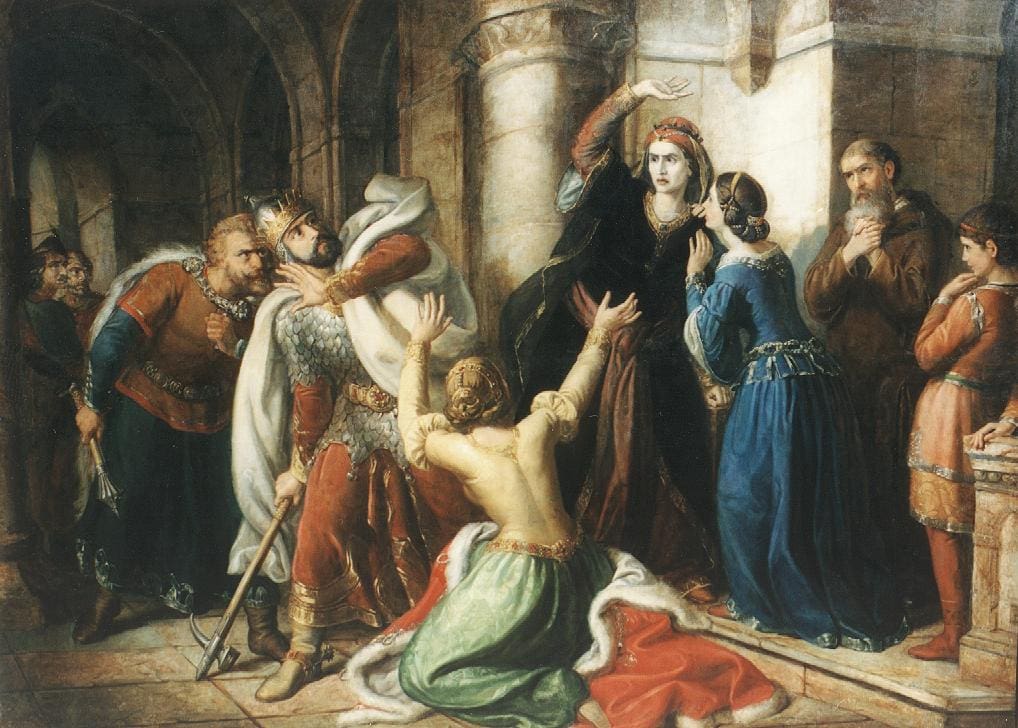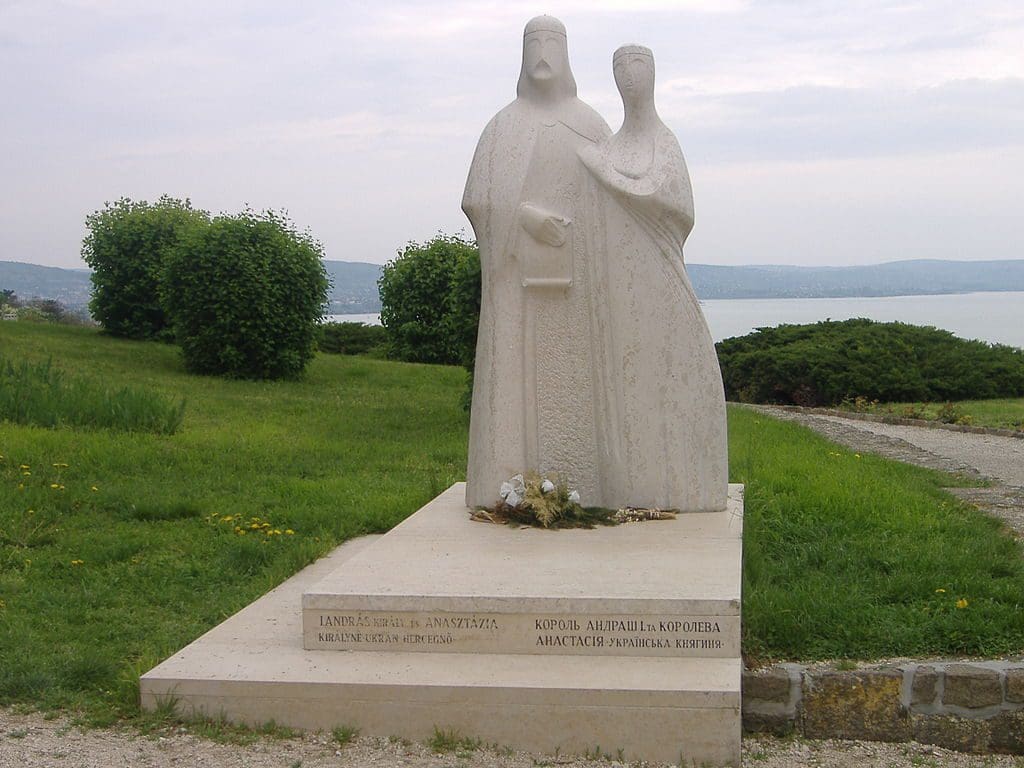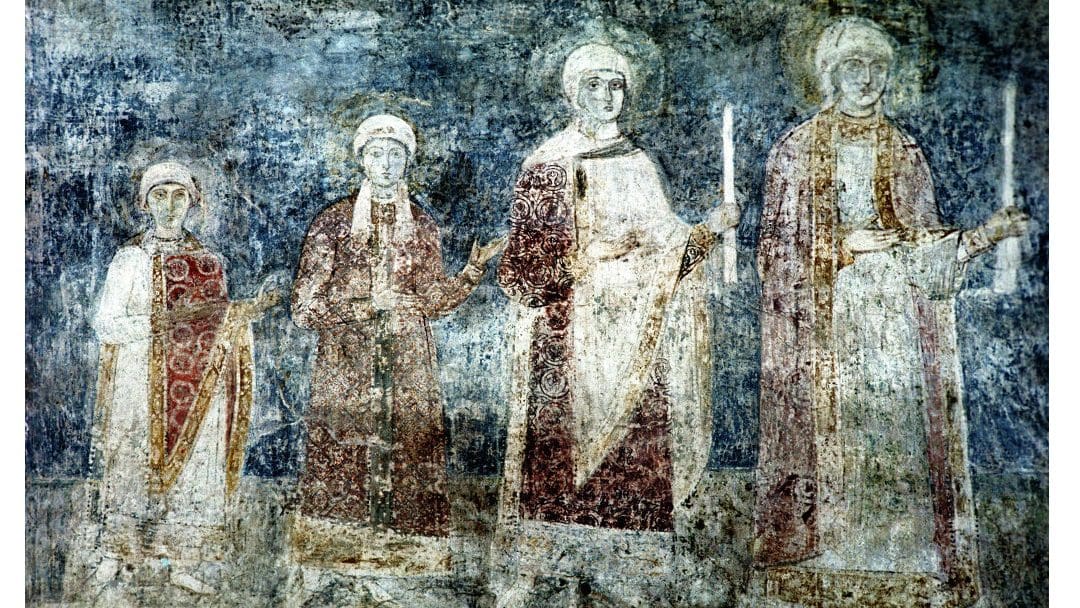Anastasia of Kiev (c. 1023–1074/1094) was one of the daughters of Grand Prince Yaroslav I the Wise, who ruled during the heyday of the Kievan Rus’. The strength and significance of the Rus during Yaroslav’s time is demonstrated by the royals his daughters married—Anastasia married a Hungarian monarch, Anne of Kiev a French (Henry I), and Elisiv of Kiev a Norwegian king (King Harald III of Norway); while Agatha (whose relation to Yaroslav is disputed, but most likely she was his daughter) wed a potential heir to the throne of England (Edward the Exile).
Anastasia married Duke Andrew of Hungary (later King Andrew I) around 1038, during the decade of exile the Hungarian royal spent in the Kievan Rus’.
Marriages between the Árpád dynasty and the Ruriks (Anastasia’s royal family) were common at the time
—as a matter of fact, 15 marriages were formed between the two dynasties, thus there is no other dynasty the Árpáds had more marital ties with.
Andrew was the king of Hungary between 1046–1060 (until his death). Andrew’s father, Vazul was a cousin of Saint Stephen, the first king of Hungary, and was blinded and brutally executed by the king after conspiring to usurp the throne. Subsequently, Vazul’s sons, including Andrew, were forced into exile.
Andrew found shelter in the Kievan Rus’, as his father had also been married to a member of the Rurik dynasty, and only returned to Hungary in 1046 as a reigning monarch after defeating King Péter Orseolo with the help of the rebels of the Vata pagan uprising. Anastasia followed his husband to Hungary and joined him on the throne as Queen of Hungary in 1046.
For many years, the couple did not succeed in having a son. The absence of a male royal heir made Andrew’s brother, Béla, believe that he was next in the line of succession to the Hungarian throne after Andrew’s death. He strengthened his position in Hungary, so much so that he received a sword—the symbol of the ducal power in Hungary, almost on par with the crown that represents royal power—and one-third of the Hungarian Kingdom as his to govern. The Duchy (the division of power between the two brothers, King and Duke) worked only until 1053, when Queen Anastasia gave birth to Solomon. The birth of an heir led to bitter fights for the throne between the brothers.
In December 1060, Béla defeated his brother and was subsequently crowned King of Hungary.
Anastasia was forced to flee to Austria with Solomon.
Shortly after their exile started, however, Béla died in a peculiar accident: the throne he was sitting on collapsed on him. As a result, with military assistance from Duke Otto of Bavaria whose sister Solomon was engaged to, Solomon became King of Hungary (1063–1074). In return for his troops, Anastasia rewarded Duke Otto with great treasure—legends say that the Queen gave Otto the sword of Attila the Hun. The sword was believed to have magical properties, and was also known as the Sword of Mars for helping Attila achieve victory after victory in his conquests. It allegedly belonged to Attila and is now kept in the Habsburg Imperial Treasury in Vienna.
Following his mother’s advice for a while, Solomon governed the country jointly with his cousins (i.e., with Béla’s three sons). After some time, however, the King, who had become a young adult, got tired of listening to his mother. Solomon began heeding the advice of his self-picked advisors instead and, against Anastasia’s instruction, turned against his relatives to rule the country by himself.
In 1074, Béla’s sons and Solomon went into battle, which Solomon lost. He fled to the West of Hungary where he could maintain control over only a limited number of Hungarian counties. Legend has it that when his mother reminded him of his foolish acts, Solomon raised his hand against his mother, and almost hit her but for the intervention of his wife, after which he was cursed by Anastasia.
The worsening relationship between Solomon and his mother forced Anastasia to
leave her son and become a nun in the Admont Abbey in Austria where she lived until the end of her life.
A famous portrayal of the Queen, was made centuries after her death, is by Soma Orlai Petrich, 1822–1880) and depicts the moment after Solomon raised his hand against his mother. Soma Orlai Petrich, the Hungarian painter, born to a half-Serbian family, is best known for his history-themed works such as The Corpse of Louis II and King Solomon Is Cursed By His Mother (i.e., by Anastasia). Petrich also painted the portraits of famous Hungarian national poet Sándor Petőfi and his parents—Orlai was the second cousin of Petőfi.

The most famous contribution of Anastasia and her husband Andrew I to Hungarian history is the establishment of the Tihany Abbey. Allegedly,
Anastasia was the one who convinced his husband to establish the abbey in Tihany.
It is believed that she selected the spot on the hills where the monastery stands now because she enjoyed spending time there. Some also believe that the stones that were used as a foundation for the building were brought to Hungary from Kiev, while the first hermits of Tihany also arrived in the country from the Kievan Rus’. What is certainly known about the Abbey is that it was established in 1055 as an important regional Christian religious centre at a time when pagan rebellions were still common in Hungary.
In addition to sealing Hungary’s Christian foundation, the Establishing Charter of the Abbey of Tihany is known for including the oldest written words in the Hungarian language. The charter, which is mainly a Latin text, contains a total of 58 Hungarian words—as we have written earlier. The longest and best-known of these phrases is ‘feheruuaru rea meneh hodu utu rea’ (‘Fehérvárra menő hadi útra’ in modern Hungarian, meaning ‘onto the military road leading to Fehérvár’), which described the location of the monastery.
What also underlines the Abbey’s significance is that both Andrew I and his son Prince David were buried in Tihany—Andrew I is the only medieval Hungarian king whose grave has been preserved to this day.

As the founders of the monastery, both Anastasia and Andrew I are fondly remembered by Hungarians. The statue of the royal couple is also one of the hallmarks of the intertwining of Ukrainian and Hungarian history, as we have argued earlier in an article. The white marble monument created by Bohdan Korzs and Oleg Turik and sponsored by the Ukrainian national self-government in Hungary, as well as the municipality of Tihany, was erected in 2001. As the website of the Ukrainian self-government stresses, ‘the statue is a marvellous testimony to the good-neighbourly, historical relations of the two nations.’
Related articles:








